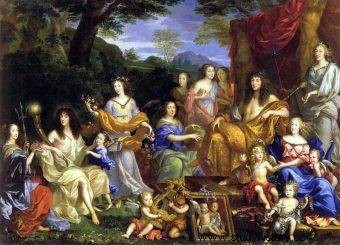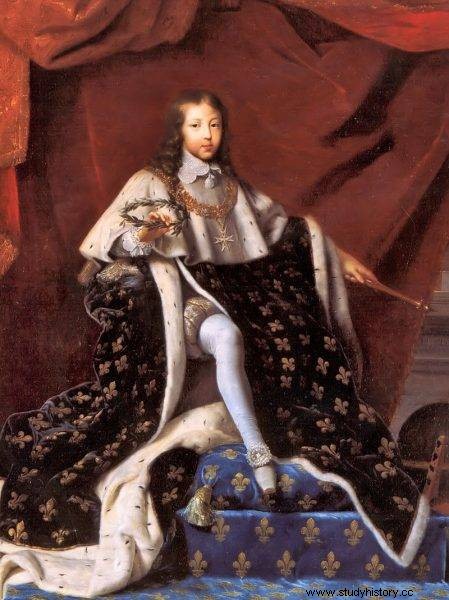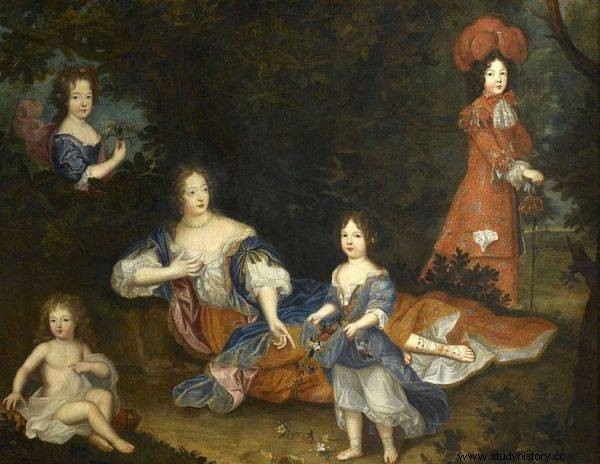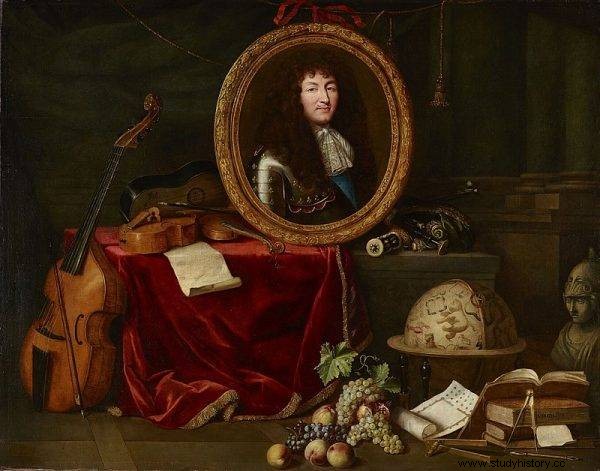He lived 77 years (four days excluded) and ruled for 72 years, three months and 18 days. He ruled the longest among European rulers, and he went down in history as Louis XIV the Great. And for good reason, although there was a lot of dirt under the golden halo of the Sun King. And not only because the monarch was at odds with hygiene ...
Dirt, stench and ... splendor - this is how you can briefly describe the Versailles of Louis XIV. Faeces in the palace corridors were cleaned only once a week, and the ruler himself avoided bathing (he was supposed to take it only twice!). He masked unpleasant smells with powders and heavy perfumes. Besides, it was not the only thing in his life that - more or less successfully - he was trying to cover up.
King of Propaganda
Behind his image of the magnificent Sun King stood ... a whole team of painters, chisels, feathers, as well as scissors and batons. Example? After the victory of the French over the Spaniards at the Battle of Rocroi in 1643, the engraving depicts the moment when the triumphant ruler congratulates the general in command of the French troops. The image had a meaningful title:"The First Victory of Louis XIV" . The artist - or anyone around the king - did not seem to mind that the monarch was only five years old at the time.

Louis XIV was surrounded by an aura of divinity. In many ways, however, he was just… human.
And, in fact, no wonder, after all, the myth of Ludwik began to appear from the day of his birth (or even earlier). The mere fact that Queen Anne of Austria became pregnant and gave birth to an heir to the throne after more than twenty years of vain endeavors was widely regarded as a miracle.
Dolphin, who was born on September 5, 1638, was immediately named Dieu Donné, or God's gift . Little Ludwik as if he wanted to prove the truth of this term himself, immediately after birth presenting two teeth - which was considered a good omen. In later years, too, he made many references to his divine connections. In a way, he also created himself to be God by writing:
I'm informed of everything; I hear the smallest of my subjects; at all times I am aware of the number and quality of my troops and the condition of my fortresses; I constantly give orders so that they do not lack anything; I receive and read messages; I myself answer some of them, and for others, I instruct the secretaries how to answer them; I am determining the amount of income and expenditure of my country.

Louis XIV during the coronation
The image of the infallible, merciful, absolutely ruling ruler was supported by court painters and sculptors, composers and poets (Molière praised him with the words:"Is he not a miracle seen on earth?"). Historian Piotr Dmitrowicz commented in an interview with Polish Radio:“He ruled in an aura of divinity and absolutism. When he was dying, he was to say to the touched courtiers:"Would you believe that I really am immortal?" ".
However, in order for the Sun King's star to shine with a bright (even blinding) glow for almost eight decades, his "glory factory" had to be in full swing ...
Pleasure bed
An important element in creating royal fame were also ... love conquests. Like many of his predecessors and successors, Ludwik did not loyalty to his wife, married for the sake of the state, Maria Teresa Habsburg, who bore him six children (only one - his first-born son Ludwik - lived to adulthood; the Grand Delfin, however, did not receive the throne, because his father he survived both his son and grandson; Louis XV was the great-grandson of the Sun King).
Through his - there was no - royal bed a lot of women passed. As Vincent Cronin claims:“Ludwik adhered to the principle that no one, even his closest friends, interfered in his affairs. "Being more inclined to romance than anyone in his kingdom", he wanted to love freely and fully ". The writer Jean-Baptiste Primi Visconti, who lived at the turn of the 17th and 18th centuries, explained the royal lust:
Every lady at court had ambitions to become the King's mistress. Many married and unmarried ladies have told me that it is not an offense to my husband or to God to strive to be loved by a ruler. So we must be lenient to the King if he succumbs to so many temptations.

The Marquis de Montespan bore Louis seven children
No wonder then that Ludwik had a large group of illegitimate descendants. Interestingly, he did not recognize most of them (although, according to one hypothesis, he himself was illegitimate, as his father was not supposed to be Louis XIII, but ... Cardinal Mazarini).
The whole of France lived with Louis' loves, and his favorites went down in history for good. The most famous were Louise Françoise de la Baume le Blanc, Françoise Athénaïs de Rochechouart de Mortemart (Marquis de Montespan) and Françoise d'Aubigné (Marquis de Maintenon), with whom he secretly married.
Food that melts in your mouth
The ruler did not avoid debauchery not only in the bedroom. He also devoted himself to… eating with equal enthusiasm. He used to say that you can know a good person by how much he eats. At the same time, he was a real foodie (about 500 people worked in full steam in the royal kitchen, and the meals were so refined that the monarch ordered the courtiers to bow down to them) and quite a glutton. Wika Filipowicz describes:
We usually ate in silence, as the king preferred to focus on assimilating the next dishes rather than having conversations. He ate a lot and greedily. The amount of food he consumed, even at a time when generally abundant food was eaten, was astonishing.
His table - nomen omen - was dominated by meat (including turkeys imported from North America), soups, fruit, sophisticated sweets and cheeses imported from the farthest corners of the country. He encouraged his chefs to compose ever more sophisticated dishes (e.g. veal tongue with truffles in puff pastry or asparagus baked in béchamel) . Descriptions of his meals for which he could eat (for one sitting!) Have survived in the sources:"four kinds of soups, a whole pheasant, partridge, a plate of lettuce, mutton in its own sauce with garlic, two pieces of ham and a plate of sweets".
It was not uncommon for him to feast for someone else's money. He often visited the house of wealthier subjects - after the coronation on June 7, 1654, it became a custom to visit the house of this or that notable at mealtime. Of course, the ruler could not be taken just by anything, so the hosts lost their fortunes for truly luxurious feasts in honor of Ludwik.
It also happened at least once that a royal feast cost the life of a majordomo. François Vatel, a servant at the court of Duke Louis II de Condé, committed suicide when it turned out that at dinner on two tables intended for less distinguished guests, insufficient space was served and the delivery of fish for the following evening was delayed ...
In a (un) healthy body…
One "minor" issue disturbed Louis XIV in savoring exquisite dishes. Well, this famous ruler… had no teeth. For this reason, his chefs had to specialize in making pates, cream soups, and various other dishes that could be eaten without chewing.
How did the Sun King's radiant smile come to be toothless? His court physician Antoine d'Aquin played a significant role in this. He was right to believe that broken teeth contributed to disease, so one by one he removed the monarch's "source of trouble". However, the solution turned out to be not very effective. Not only that Ludwik had to eat only food that literally melted in his mouth for the rest of his life, but he also struggled with a number of more or less serious ailments.

A staff of generously paid artists took care of the proper image of the ruler.
And so on the list of his diseases were:migraines and indigestion (possibly resulting from a tapeworm infection), gout, as well as an anal fistula, which was operated twice. It is almost a miracle that Ludwik managed to live to the old age of 77 for those times. Especially if you take into account the level of medical "care" he was surrounded with (the reports of the court medics show, among other things, that in the course of his life the king was given more than two thousand enemas ...).
Overall, however, it can be said that Ludwik was in good health. His condition deteriorated rapidly only shortly before his death - in the summer of 1715. Vincent Cronin describes:
He lost weight, his cheeks were sunken, he lost his springy gait. His appearance ceased to deceive - he was a seventy-six-year-old man who did not enjoy the best of health. The news of the king's health spread throughout Europe and became a topic of conversation in its capitals. Bets were made in London as to whether Ludwik would live to see the end of September.
He did not live to be. He died on September 1, 1715, after gangrene suffered a cut on his leg. He was buried in the Basilica of Saint-Denis in Paris - the embalmed heart was put in a separate casket. Apparently, after looting the temple during the revolution in 1793, it fell into the hands of an eccentric collector who ... ate its contents.
Bibliography:
- G. Bordenove, Louis XIV , World of Books 2006.
- P. Burke, Manufacture of Louis XIV , Publishing House of the University of Warsaw 2011.
- V. Cronin, Louis XIV , Da Capo 2001.
- P. Gaxotte, Louis XIV , State Publishing Institute 1984.
- W. Filipowicz, At the table with the king. As feasted at the royal court , Horizon 2020 sign.
- A. Levi, Louis XIV. The age of intrigue and conspiracies , Bellona 2008.
